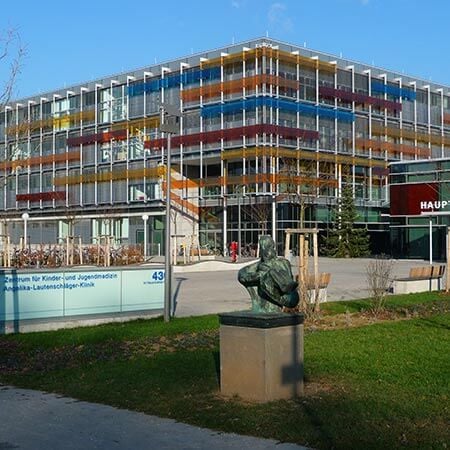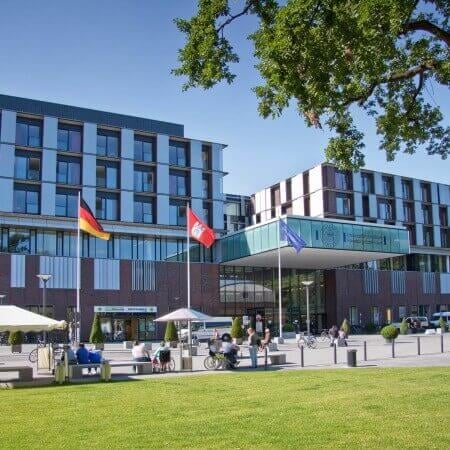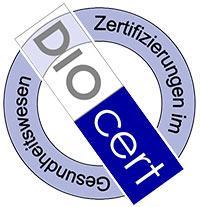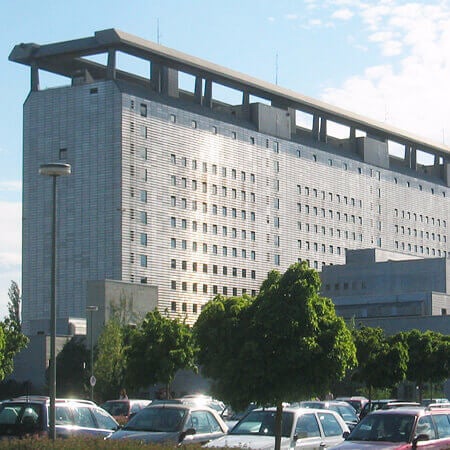Uterine fibroids are smooth muscle tissue proliferations. These tumors are benign, but in many women they cause abnormal bleeding, pelvic pain, infertility, and miscarriage. You can undergo your treatment for uterine fibroids in Germany. You are welcome to visit the Booking Health website to find out the cost of treatment and choose a medical care program at the best price.
Content
- Conservative treatment
- Hysterectomy
- Myomectomy
- Myolysis
- Uterine artery embolization
- High-intensity focused ultrasound
- Other treatment methods
- Why to undergo your treatment in Germany?
Conservative treatment
The size of uterine fibroids can be reduced with medications. The most effective are GnRH agonists, which cause an artificial menopause. It is completely reversible, and fertility will be restored after drug withdrawal.
The problem with this treatment is that it has a temporary effect. Discontinuation of medications results in the restoration of a myoma to its original size. This method is therefore mostly used when preparing for surgery.
Theoretically, a complete elimination of symptoms for a long time can be achieved if GnRH agonists are used continuously. The maximum duration of use of these drugs is, however, limited to 6 months, as they cause symptoms of hypoestrogenism (the same as in the case of menopause) and bone tissue demineralization (osteoporosis).
Hysterectomy
An operation for uterus removal allows for a cure for uterine fibroids in 100% of cases. A myomatous node will definitely not develop again since there is nowhere else for it to develop after the operation. The treatment method is unacceptable for young women, especially for those with reproductive plans, but is often used for women who have menopause. Most hysterectomies in developed countries are performed specifically for myomas.
Doctors in Germany perform a hysterectomy mainly using vaginal or laparoscopic methods, while surgical procedures with a large abdominal incision are almost never used. Sparing hysterectomy techniques allow a woman to recover faster. After 2 weeks, she can return to her usual life, and full recovery takes 6 weeks.
It is important to have this operation at a good hospital to avoid any complications, such as colon, bladder, or urethral lesions. If you are going to have your treatment of uterine fibroids in Germany, the specialists from the Booking Health company will help you select a hospital with the lowest complication rate.
Myomectomy
A surgical procedure for myomatous node removal has been used in medicine for more than 150 years. It can be performed through various surgical approaches, namely open surgery (laparotomy), minimally invasive intervention through short abdominal incisions (laparoscopy), or endoscopic surgery, which is performed from inside the uterus (hysteroscopy). How a doctor will remove the tumor, through the abdomen or from inside the uterus, depends on the location of the neoplasm. A hysteroscopy is used for submucosal uterine fibroids. A laparoscopy can be performed to remove subserosal or intramural myomas.
The simplest operation is when the doctor removes a single pedunculated tumor that protrudes largely into the uterus or abdominal cavity. It is much more difficult to remove large and multiple tumors without any pedicles, especially in patients with a previous myomectomy. In this case, you should choose the best doctor with vast experience in the reconstruction of the uterus to perform the operation. This will increase your chances of maintaining fertility and having a vaginal birth.
Doctors in Germany perform a myomectomy with less blood loss. They use preoperative embolization, misoprostol, bupivacaine intramyometrial injections with epinephrine, vasopressin, or tourniquets. As a result, women are less likely to need blood transfusions and recover faster after surgery. In Germany, operations are performed using a laparoscopic approach. This additionally reduces blood loss as compared to a laparotomy, shortens the length of a hospital stay and a recovery period, and reduces the risk of abdominal adhesions, which cause infertility and complicate future gynecologic operations. A recovery period after a laparotomy takes up to 8 weeks. Nonetheless, when women have a laparoscopy, it takes only 2 weeks to recover, and the recovery period after a hysteroscopy is only 1 week.
Myolysis
Myolysis is a minimally invasive intervention that allows for the destruction of uterine fibroids with various energies. Doctors can use several types of this procedure:
- laser;
- bipolar electrocoagulation;
- radiofrequency coagulation;
- cryomyolysis (freezing with liquid nitrogen).
The procedure is usually performed through a laparoscopic approach. It violates the structure of myomas and provides a long-term effect. At the same time, the manipulation is minimally invasive, safe, and does not require a long hospital stay. Recovery time is just a few days.
Myolysis is an organ-sparing treatment, but it is only suitable for women who do not have any reproductive plans. As a result of the procedure, the muscle tissue of the uterus is replaced by scar tissue. This leads to abnormal placentation and a potential uterine rupture during a pregnancy.
Doctors in Germany successfully perform myolysis for patients with multiple uterine fibroids. They use methods of intraoperative diagnostics (imaging) that allow them to detect even small tumors that are entirely located in the wall of the uterus.
Uterine artery embolization
Another sparing treatment method for uterine fibroids is to close the lumen of the arteries that supply them with blood. This is a minimally invasive procedure performed through a small incision in the groin. The arteries in the uterus are approached under fluoroscopic guidance. Doctors inject a mass of trisacryl gelatin microspheres or polyvinyl alcohol particles into the blood vessels.
The uterine arteries are responsible for 94% of the blood supply to myomas. The rest of the blood comes from the ovarian arteries. Infraction of the myomatous nodes therefore occurs immediately after the procedure, as a result of which they die due to oxygen deficiency.
Uterine artery embolization is considered the best treatment option for intramural fibroids. It can also be used for submucosal fibroids, but in this case, most doctors prefer a myomectomy through a hysteroscopic approach. Embolization cannot be used for pedunculated tumors or any type of neoplasm larger than 8 cm.
Uterine artery embolization has been used in gynecology for decades. This procedure has been well researched. In 1999, the Fibroid Registry for Outcomes Data (FIBROID) was established, which has already collected information on the outcomes of more than 3,000 women from 72 centers. According to this registry, 82% of women did not experience any symptoms and were completely satisfied with the results of their treatment 12 months after the procedure. Only 5% of patients get no therapeutic effect, and only 3% of women subsequently need a hysterectomy. At the same time, embolization is one of the safest treatment methods for uterine fibroids. The risk of developing severe complications after the procedure is only 0.66%.
High-intensity focused ultrasound
Myomas can be destroyed by MRI-guided focused ultrasound (MRgFUS). The advantage of this technique is its non-invasiveness, as no incisions and punctures are required. The ultrasound is directed into the tumor through the abdominal wall. This is an outpatient procedure that lasts from 2 to 4 hours. The recovery time is 3 days.
The technique is an alternative to myolysis, but at the same time, it is more sparing and also more effective. Doctors control the procedure constantly, which excludes insufficient or excessive impact on the tumor.
Ultrasound ablation is used predominantly in premenopausal women with uterine fibroid symptoms who do not wish to maintain their fertility. This method is good because it can be used for any type of myomas: intramural, subserosal and submucosal. However, ultrasound cannot be used for pedunculated tumors, as well as in the case of myomas adjacent to the bladder or colon.
Other treatment methods
In gynecology, new treatments for uterine fibroids are constantly emerging. They have not yet become widespread, but are already being used at some German hospitals. The following methods are rarely used for the treatment of uterine fibroids:
- Laparoscopic uterine artery occlusion involves the closure of the uterine artery lumen through a laparoscopic approach.
- Doppler-guided uterine artery occlusion (D-UAO) is a minimally invasive procedure performed on an outpatient basis through the vagina. Doctors use a vaginal approach to temporarily close the arteries of the uterus. Blood clots then form in them, and the blood supply to the myomatous nodes stops.
- MRI-guided interstitial laser photocoagulation involves the destruction of the tumor with a laser. Unlike myolysis, a laparoscopic approach is not required. Accuracy is achieved through intraoperative diagnostics. Doctors insert probes through skin punctures and place them in the tumor under MRI guidance.
Why to undergo your treatment in Germany?
You can opt to undergo your treatment in Germany. This country uses the latest techniques that are more sparing and safe. Doctors prefer organ-preserving surgical interventions. For women with reproductive plans, doctors at German clinics use procedures and operations to preserve their fertility and increase the chances of a natural childbirth without a C-section.
There are a few reasons for you to undergo your treatment of uterine fibroids in Germany. These are the following:
- Diagnostics in Germany are very accurate. Physicians determine the size and location of myomas, the number of tumors, and the peculiarities of the blood supply to plan treatment perfectly.
- An individual selection of the treatment method is made, taking into account the wishes of the patient, her age, the presence of reproductive plans, and ovarian function.
- Instead of traumatic surgery through large abdominal incisions, surgeons perform minimally invasive laparoscopic interventions with a recovery period of 2 weeks.
- Doctors at specialized centers in Germany have vast experience in myomectomy. They perform it with a low risk of complications and good results: a woman can maintain her fertility and give birth to a child through the natural birth canal in the future.
- Women who do not have any reproductive plans undergo minimally invasive procedures instead of surgery. These may be myolysis, uterine artery embolization, or high-intensity focused ultrasound ablation.
- Adequate anesthesia for all procedures, symptomatic therapy and care in the postoperative period, and comfortable conditions are available at German hospitals.
You are welcome to use the Booking Health service to find out the cost of treatment and diagnostics in Germany, compare prices, and choose a medical care program at a favorable price. Our specialists will help you select a hospital and arrange your trip. The cost of treatment for you will be lower than if you contact the hospital directly, due to the absence of additional coefficients for foreign patients. The initial cost of treatment is guaranteed not to increase after the start of the medical care program, as all extra medical expenses will be covered by insurance.
Authors:
The article was edited by medical experts, board-certified doctors Dr. Nadezhda Ivanisova and Dr. Sergey Pashchenko. For the treatment of the conditions referred to in the article, you must consult a doctor; the information in the article is not intended for self-medication!
Sources:
Healthline
Verywell Health
MedicineNet




















